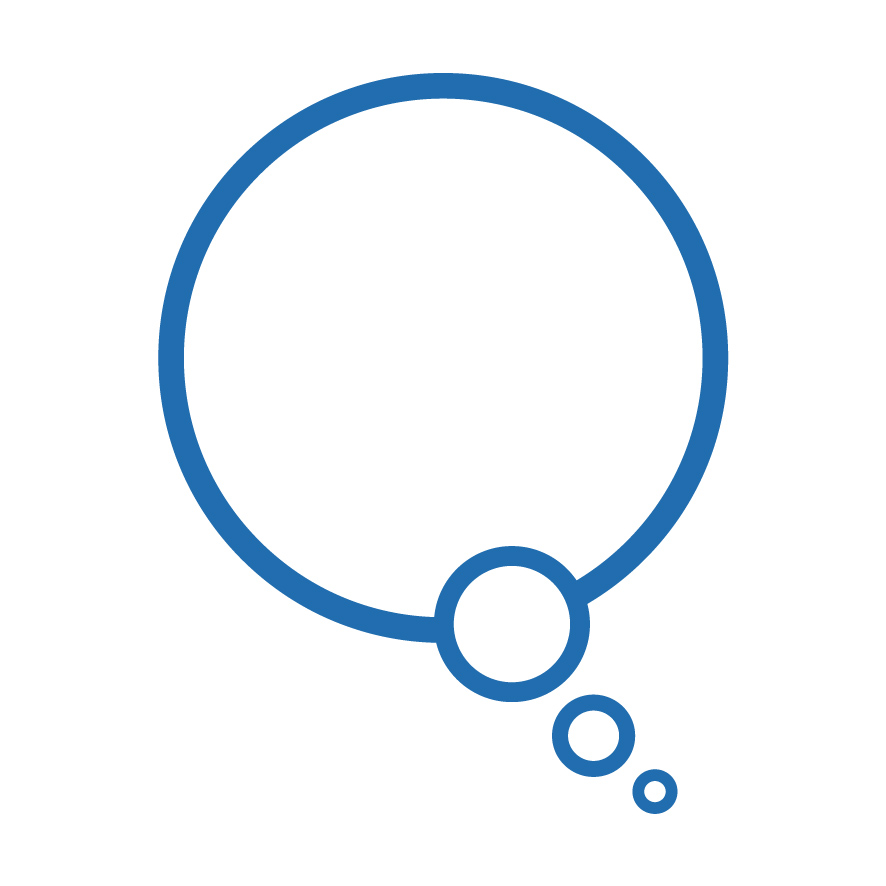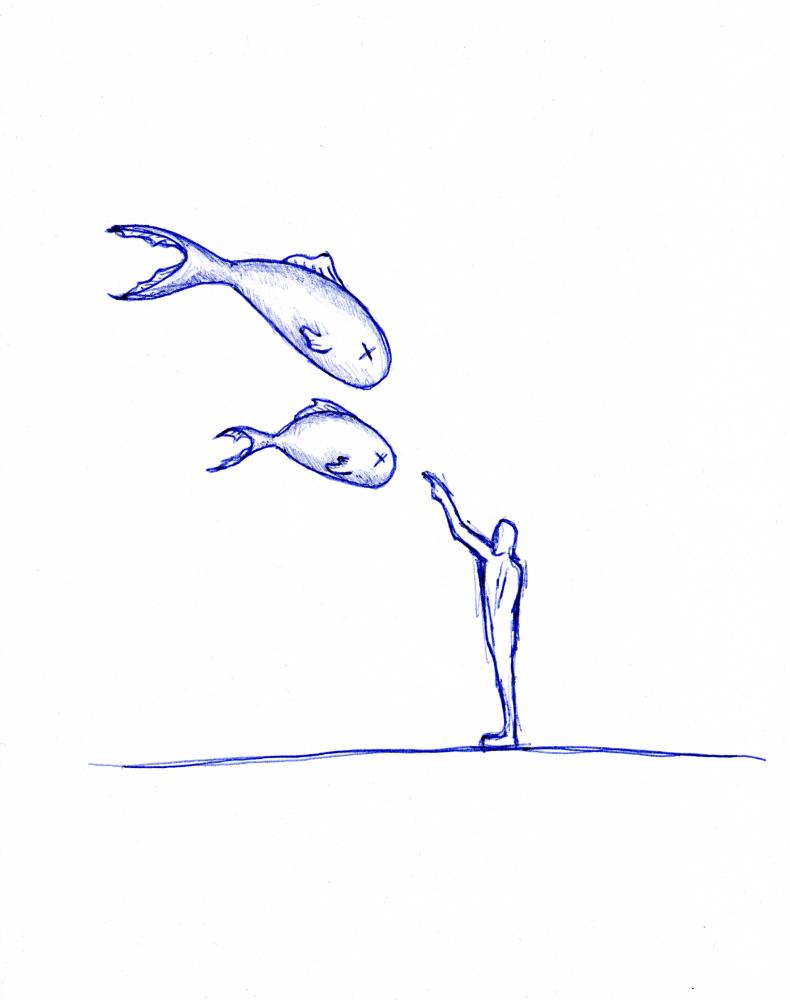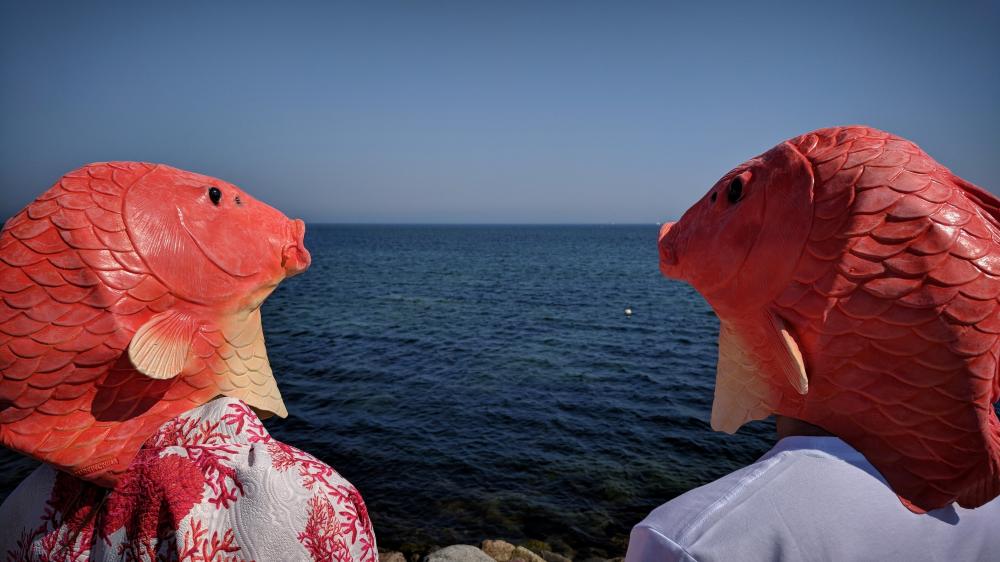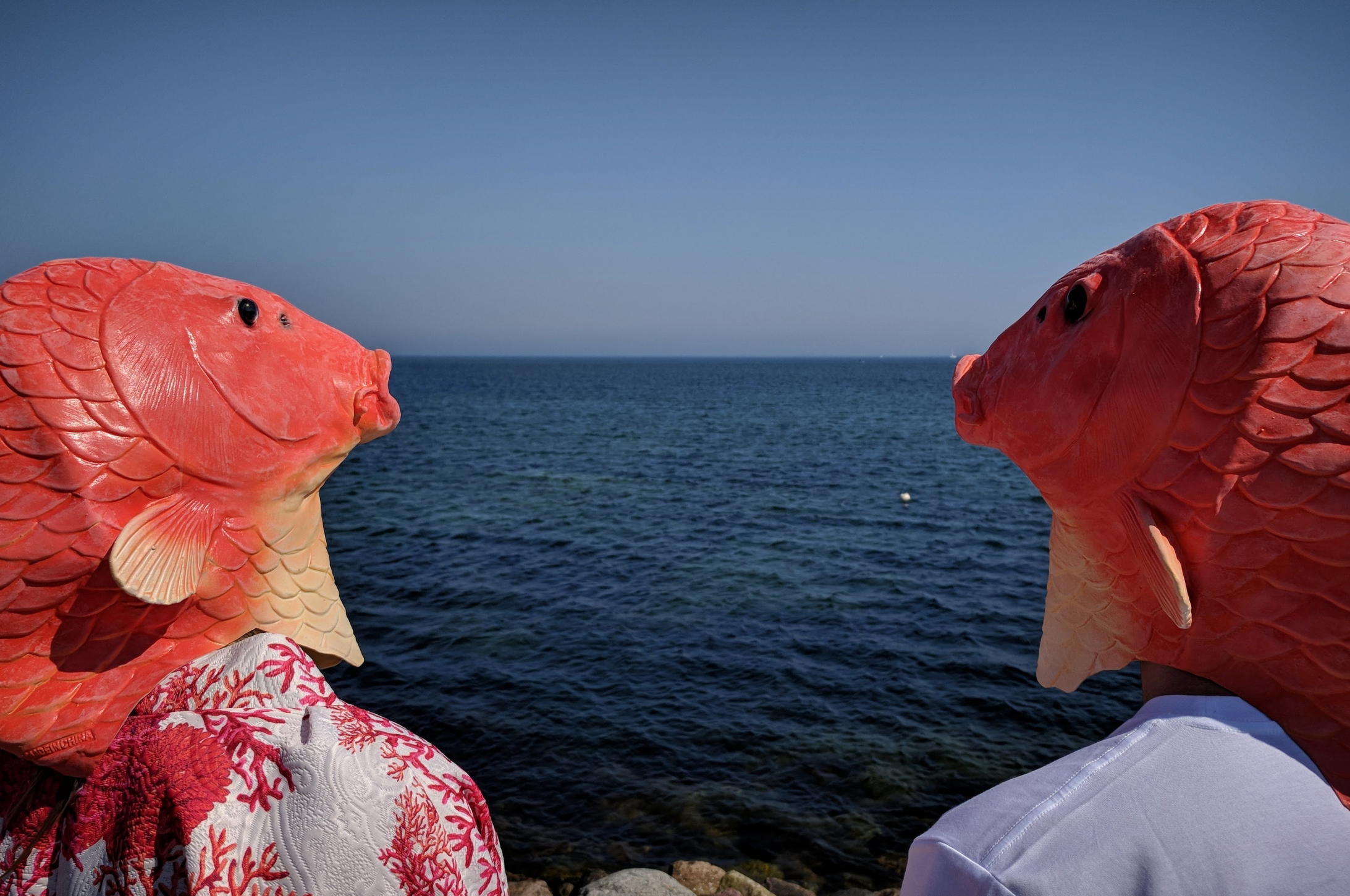DEEP SEA MINDING
Danish artist group SUPERFLEX begins a three-year cycle as Expedition Leaders of The Current with an expedition through the islands of Tonga.
The deep sea is closer than ever. Global warming is causing an unprecedented rise in the sea level, which will drastically reshape our planet. Dry ecosystems, including human landscapes, will soon be submerged. Great migrations will happen, and all species will be forced to survive extreme changes in their habitats. As the water rises, molluscs, fish and algae will occupy our cities, homes and parking lots. Every object created by humans will potentially end up underwater: cars, televisions, fish bowls. When the depths of the sea finally reach the places that we have carefully designed and built, their original function and aesthetics will be lost. It is time to consider if water will then become a destructive force or an element of transformation. Apart from continuing to fight the causes of climate change, we should also prepare for the inevitable arrival of the ocean.
Deep Sea Minding is a project by SUPERFLEX that merges artistic and scientific research in an attempt to reach an alternative understanding of the marine species, which could ultimately affect the way we imagine and design our environments and objects. While generating relevant data and increasing awareness of rising sea levels, Deep Sea Minding proposes the creation of structures that could serve the needs and desires of both humans and marine creatures. In August, SUPERFLEX initiates the first of three expeditions to the South Pacific to test marine life responses to the nature of these designed structures. Documentation of the progress of this research will be accessible online and interaction with the project possible through the land-based annual Convenings.
Deep Sea Minding is a three-year transdisciplinary research project conceived by the Danish artist group SUPERFLEX and commissioned by TBA21–Academy. SUPERFLEX will be Expedition Leaders of the second cycle—spanning 2018-20—of TBA21–Academy’s three-year fellowship programme The Current. The first expedition—Deep Sea Minding—aboard the M/Y Dardanella research vessel, brings a series of exploratory experiments to the uninhabited island of Hunga Tonga-Hunga Ha’apai, in the South Pacific. The island of Hunga Tonga-Hunga Ha’apai emerged recently in the South Pacific, challenging the prevailing tendency of a world which is slowly sinking. The perfect location to explore the thin and ever-changing frontier between land and sea. A frontier which will be soon diluted by a vertical migration: bringing fish to occupy our homes and humans to mind the deep sea.
PARTICIPANTS
Dr Dayne Buddo
Chief Executive Officer of Alligator Head Foundation
He is a marine ecologist with expertise in marine invasive alien species, fisheries management and marine protected areas. He has been a consultant for marine projects for CARICOM, Government of Japan, the World Bank, International Maritime Organization, the Nature Conservancy, among others, and has conducted work in over 30 countries. He has worked closely with the United Nations Convention on Biological Diversity (UNCBD), International Union for the Conservation of Nature (IUCN), United Nations Environment Programme (UNEP), and the Global Environment Facility (GEF), The National Oceanic and Atmospheric Administration (NOAA) among other multilateral agencies. Dr. Buddo currently serves on several national and regional committees that focus on marine invasive species and marine biodiversity, including the CITES Scientific Authority, Fisheries Management and Development Fund Board and the Marine Park Advisory Board. Most recently, he was asked to serve on a global task force for ballast water by the International Maritime Organization and the United Nations Intergovernmental Panel for Biodiversity and Ecosystem Services. He also sits on the Board of Advisors for The Ocean Foundation based in the United States.
Ricardo Gomes
Architect and co-founder of KWY.studio
Born in Coimbra, Portugal in 1978 and studied architecture in Lisbon between 1995 and 2001. Worked at the Chinati Foundation in Marfa between 2002 and 2004. From 2005 to 2011 he worked with the artist Olafur Eliasson in Berlin. Between 2011 and 2014 he was an assistant professor at the UDK in Berlin and between 2015 and 2017 he taught art at DIS Copenhagen. He lives in Lisbon and Copenhagen.
Dr Barbara Imhof
Architect and co-founder of the LIQUIFER Systems Group
She was educated in architecture Vienna at the University of Applied Arts in the studio of Wolf D. Prix - Coop Himmelb(l)au, at the Bartlett School, London, SCI-ARC, Los Angeles and holds a Master Degree in Space Studies from the International Space University including a PhD from the University of Technology Vienna. Barbara worked as a space architect for NASA, being responsible for the interior design, on NASA’s BIOPLEX Project (Earth test bed for a human mission to Mars) at the Johnson Space Center in Houston. For the European Space Agency (ESA) she co-led a feasibility study of an integrated planetary exploration simulation facility. Other ESA projects where she served as an expert for space architecture include the Human Mission to Mars Study and the ExoMars Rover Study for robotic exploration. Barbara led the project RAMA, a concept design for a pressurized rover for Moon/Mars exploration, which was part of the top-level Architecture Study of the ESA's European Exploration Strategy. The design was developed under a contract to Thales Alenia Space and ESA.
Dr Alex Jordan
Max Planck Institute Department of Collective Behaviour
He is a Principal Investigator at the Max Planck Institute Department of Collective Behaviour. Prior to this, he was the Integrative Biology Fellow at the University of Texas at Austin, working in collaboration with Mike Ryan and Hans Hofmann and before that a JSPS fellow in Osaka working with Masanori Kohda. He completed his PhD with Rob Brooks and Ashley Wardin Sydney, and he did his undergraduate honours thesis with Madeleine Beekman and Ben Oldroyd in Sydney as well. His research is methodologically broad, with projects examining the effect of social hierarchy on collective behaviour, the flow of information through social groups, the sources of selection acting on behavioural traits, and the neurobiological basis for variation in social and reproductive behaviour. He uses fish, insects, and spiders in the lab and field sites from Australia, Africa, and Central America.
Jun Kamei
Biomimicry designer and material scientist
Jun is a biomimicry designer with experience in material science research and product design. Juggling between London and Tokyo, between advanced research and design. He is currently working at the RCA-IIS Tokyo Design Lab, an international collaborative initiative between the Royal College of Art and the University of Tokyo. He is passionate about nature’s hidden design and our interaction with the surrounding natural environment. He is currently reimagining a new amphibian way of living for when our cities become a mix of permanently flooded area and dry architecture.
Maureen Penjueli
Coordinator, Pacific Network on Globalization a regional NGO dedicated to promoting self determination agenda of Pacific peoples.
Maureen Penjueli was born on the island of Rotuma but spent most of her schooling life in Lautoka, Fiji. She has a Bachelor of Science in Australian Environmental Science from Griffith University in Brisbane, Australia. She has over 20 years of experience working in the field of environmental, political and socio- economic issues faced by Pacific islanders. Married with seven children, two dogs and a goldfish, she considers herself a student of life.
Camerman
Johan Schneévoigt
Johan is a Danish cinematographer and a gifted storyteller. Gaining an M.A. in Film Studies from the University of Copenhagen, for many years his speciality has been working as a documentarist for various national (Danish) tv channels. These days he favours working outside the field of the fast-paced world of television. Meaning he has chosen to focus on creating corporate content for top national and international corporations in various sectors.
When not working for clients he is working on his personal documentary film which centres around the colourful diversity and sometimes challenging coexistence of the people of Paris (France).










































